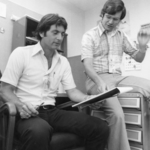William B. Shuler

William B. Shuler, a longtime Laboratory employee and former associate director, was killed in an accident Wednesday evening, March 10, 2021, near his home in Port Angeles, Washington. He was 81.
Shuler was born in Berkeley, California and well-traveled as the son of a U.S. Army major general. He graduated from the College of William and Mary in Williamsburg, Virginia, with a bachelor’s, master’s and PhD in physics, studying both astrophysics and high energy experimental physics.
Shuler joined the Lab’s A-Division in 1968 where he worked as a design physicist until 1972, making significant contributions to the understanding of one of the Laboratory’s early important Navy submarine launched ballistic missile programs, the W-68 Poseidon warhead. From 1972-74 he worked on the staff of the associate director as the responsible individual for Strategic Offensive Weapons, returning to A-Division as project manager for the Large Advanced Ballistic Re-entry Vehicle and associate division leader for Strategic Systems. In this context, he was a major participant in the Laboratory’s activities associated with the Accelerated Test Program prior to the entry in to force of the Threshold Nuclear Test Ban.
In 1978 he became head of the Laboratory’s Evaluation and Planning efforts as D-Division leader. D-Division conducted studies in such areas as tactical and strategic weapons systems and provided input that helped focus the Laboratory’s weapon design efforts. The division was responsible for the Laboratory’s core efforts in understanding weapon effects and involved in many of the early efforts to use modeling and simulation to understand tactical conflict as well as the atmospheric effects of nuclear exchanges, frequently referred to as “nuclear winter.”
In 1980, Shuler was named an associate director and head of the Military Applications Program, responsible for all of the Laboratory’s weapons system development programs from Phase 1 (concept studies) to Phase 7 (retirement, dismantlement and disposition), evaluation and planning and much of the Laboratory’s non-nuclear work for the Department of Defense. During his tenure, the W-82 AFAP, the W-84 GLCM and the W-87 MX warheads were under development and the program to develop the W-89 warhead for the SRAM II missile was assigned to Livermore. He served as a member of the U.S. Air Force Scientific Advisory Board and was extensively involved in the Laboratory’s response to President Reagan’s Strategic Defense Initiative.
Following a reorganization of the nuclear weapons program in 1988, Shuler took leadership of a variety of special projects, including an Advanced Manufacturing Initiative directed at providing modern manufacturing and processing technologies for the aging nuclear weapons complex.
In 1991, Shuler accepted an assignment with the Department of Energy in Washington, DC, providing direction to all of the department’s programs chemical, nuclear and biological weapon proliferation.
He retired from the Laboratory in 1997 and spent several years sailing around the Caribbean before settling near Sequim, Washington.
Shuler was engaging, gregarious, well rounded, athletic and able to see the big picture and focus on getting the details correct. He was generous with his time and advice, helping mentor many younger Lab associates. While at Livermore, he could often be seen playing basketball, jogging or biking at noon. He also loved skiing, backpacking, rock climbing, water skiing, and playing his guitar, often in the company of Lab friends. He often said, “While I’m climbing and backpacking I have a chance to think about the miraculous, to be out in the night air and looking up at an infinity of stars.” He loved exploring the night sky with his telescopes.
Longtime Lab associate Clark Groseclose described Shuler as “having a special talent for analyzing data for its broad implications and then putting together a presentation that tells the story in a well-organized straightforward way. When he’s finished you not only understand what he’s said, but you tend to agree with him.” It is a tribute to this skill, that the present weapon’s vault, while reorganized several times follows, Shuler’s basic outlines.
Insight into Shuler’s character also comes from two incidents reported in a June 1980 Newsline.
“A few years ago, when one member of their cross-country ski party suffered a pulmonary edema going over Donahue Pass, Shuler and (Roy) Woodruff skied ahead into Yosemite for a helicopter rescue. ‘They sort of took over,’ recalls A-Division physicist George Miller, a participant. ‘They knew what had to be done to keep the guy alive and they did it, calmly and directly.’ ”
“On another outing last year, the two (Shuler and Woodruff) came out of the Yosemite back country to find their route blocked by a typical early season high river, the sort of torrent that seasoned hikers know can kill. They turned around and set out another way, but not before some of their worried colleagues were on the way to rescue the overdue pair. ‘It was just a matter of their unwillingness to proceed in an obviously unsafe fashion,’ says Miller. ‘They’re very adventurous, but they’re also conscious of their limitations and the limitations of other people.’”
In a typically self-deprecating manor, Shuler, who played football at William and Mary, described his memory of the annual contest with the Naval Academy as, “All I remember is the bottom of Joe Bellino’s cleats.” (Bellino was Navy’s All-American, Heisman Trophy winning halfback.)
In retirement, Shuler and his wife Billie Jean were members of Sequim Community Church, where they started and taught Bible study for young Christian members, and volunteered at local soup kitchens. Shuler also organized and taught a class on rocketry.
Shuler will be missed by many friends. He leaves behind his wife, Billie Jean Shuler of Washington, his son Joseph Shuler of Washington, his sister Leslie Shuler Blain of Oregon, granddaughter Shelby Fuchs of Arizona and former wife, Jean Shuler of California.
The family has requested that remembrances be made in the form of contributions to Alzheimer’s Association.




